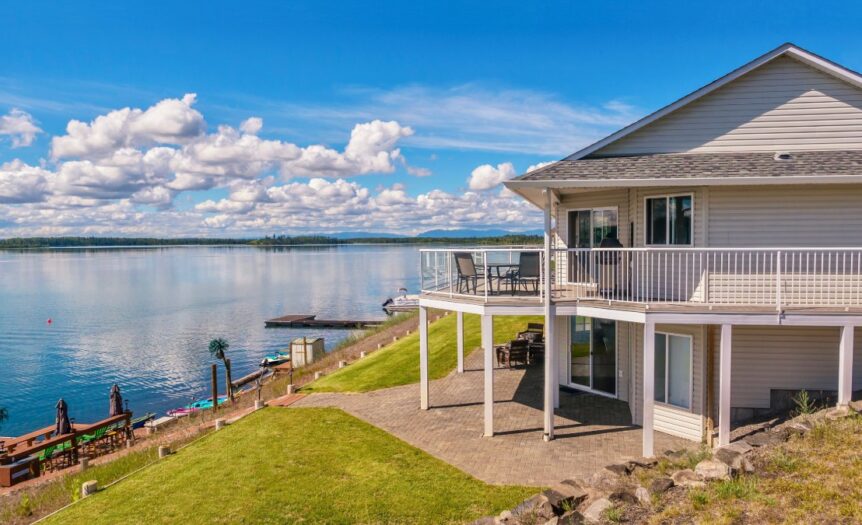Are you looking to set the stage for sunset fishing trips? Maybe you’re ready to launch into your favorite water sports. Or maybe you’re just eager to soak in the views with a morning coffee. Whatever your case may be, it all starts with one crucial decision: your dock. It’s quite literally the foundation and the starting point for your aquatic adventures.
Understandably, that’s a lot of pressure, but that’s where this guide comes in. We’ll help you navigate the critical aspects to consider so that you can choose the perfect dock for your waterfront property.
What Will You Use Your Dock For?
The first step in choosing the right dock is identifying how you plan to use it. Are you a boating enthusiast who needs a dock that accommodates your vessel, no matter the size? Or perhaps you’re more interested in creating a peaceful retreat for fishing, swimming, or lounging.
If you’re dreaming of lively summer gatherings, consider a dock design that has enough space for seating, tables, and even a grill. Understanding your needs and how you’ll use your dock will set the stage for making the right decisions.
What Are the Different Dock Types?
Not all models are quite the same, and knowing the major types can help guide your choice. Floating docks are versatile and ideal for fluctuating water levels. Stationary docks, on the other hand, offer stability and permanent construction that’s great for calm or shallow waters.
Then there are rolling docks, which are perfect for seasonal use and can be moved easily. It’s also worth considering modular docks if you’d like flexibility to reconfigure your layout as your needs change. The type of dock you choose should align with both your personal requirements and your property’s unique characteristics.
Do You Know Your Local Regulations?
Before making a final decision, take time to research local permits, zoning rules, and any environmental regulations pertaining to docks. These requirements can vary widely depending on your location.
Some areas may have restrictions on the size or type of structures allowed, while others might have rules aimed at protecting wildlife or preserving the waterway. Staying informed will ensure you avoid any headaches and set up a dock that’s compliant and stress-free.
Which Material Type Is Best for You?
When it comes to dock materials, you’ve got a range of options, each with its own pros and cons. Wood, for example, provides that classic, natural look but may require more maintenance to prevent weathering.
Aluminum is lightweight, durable, and low-maintenance, making it a solid choice for many waterfront properties. Composite decking offers a great balance of longevity and minimal upkeep, with the added bonus of being eco-friendly in many cases. Think about factors like durability, aesthetics, and cost when weighing your options.
Are You Aware of How Much Maintenance Each Option Requires?
The amount of dock maintenance you’re willing to commit to is an important consideration when selecting a dock. Wood docks may need regular sealing and repairs to keep them looking their best, while aluminum and composite docks are much easier to maintain and can last for decades with minimal effort.
Don’t forget to factor in environmental conditions—saltwater, for example, might demand more durable materials or extra care to resist corrosion. By planning ahead, you’ll ensure your dock remains a functional and beautiful addition to your waterfront property for years to come.
What Are the Weather and Water Conditions in Your Area?
Before choosing a dock, it’s vital to consider the weather and water conditions in your region. Is your area frequently windy with rough waves, or is the water typically calm and serene? Docks in storm-prone regions may need stronger anchoring systems, while those in calmer waters might allow for more flexibility in design and material choices.
Additionally, if you experience freezing winters, you’ll want to think about how ice formation might impact your dock’s structure and durability. Tailoring your dock to handle these local conditions will ensure it remains reliable and safe, no matter the environment.
Have You Kept Safety Features in Mind?
Safety should always be a top priority. Adding elements like non-slip surfaces, secure railings, and proper lighting can make your dock significantly safer for everyone who uses it. For families with young children, incorporating features like safety ladders or fencing can provide some extra peace of mind.
It’s also smart to plan for emergencies; for example, ensuring there’s easy access to life rings or ropes enhances safety in case someone falls into the water. A safe dock leads to worry-free enjoyment for you and your loved ones.
What About Long-Term Durability?
A dock is a long-term investment, so it’s important to consider how well it will hold up over time. Different materials respond differently to sun, water, and wear. Opting for high-quality, durable materials like composite decking or treated aluminum can save you time and money in the long run.
These materials often require less maintenance while standing up well to the elements. By focusing on longevity, you’ll enjoy a dock that looks great and performs well for many seasons to come.
Does It Meet Your Aesthetic Requirements?
Finally, your dock is more than just functional—it’s also part of your property’s overall aesthetic. Whether you prefer a sleek, modern design or a more rustic, natural look, there’s a dock style to suit your preferences.
Choosing customizable features like rail designs, decking colors, or creative layouts will help your dock blend seamlessly with its surroundings or stand out as a statement piece. With the right design choices, your dock can not only serve practical purposes but also enhance the beauty of your waterfront space.
When it comes to choosing the right dock for your waterfront property, the possibilities are as vast as the water it sits on. By assessing your needs, exploring different styles, and incorporating custom touches, you can create a dock that perfectly complements your lifestyle and enhances your property. With thoughtful planning and a bit of creativity, you’ll have a beautiful, functional dock that transforms your waterfront into a space to relax, entertain, and enjoy for years to come.










 Deering Estate
Deering Estate
 Massage Envy South Miami
Massage Envy South Miami
 Calla Blow Dry
Calla Blow Dry
 My Derma Clinic
My Derma Clinic
 Sushi Maki
Sushi Maki
 Sports Grill
Sports Grill
 The Healthy Kitchen
The Healthy Kitchen
 Golden Rule Seafood
Golden Rule Seafood
 Malanga Cuban Café
Malanga Cuban Café

 Kathleen Ballard
Kathleen Ballard
 Panter, Panter & Sampedro
Panter, Panter & Sampedro
 Vintage Liquors
Vintage Liquors
 The Dog from Ipanema
The Dog from Ipanema
 Rubinstein Family Chiropractic
Rubinstein Family Chiropractic
 Your Pet’s Best
Your Pet’s Best
 Indigo Republic
Indigo Republic




 ATR Luxury Homes
ATR Luxury Homes


 2112 Design Studio
2112 Design Studio
 Hamilton Fox & Company
Hamilton Fox & Company
 Creative Design Services
Creative Design Services
 Best Pest Professionals
Best Pest Professionals
 HD Tree Services
HD Tree Services
 Trinity Air Conditioning Company
Trinity Air Conditioning Company
 Cisca Construction & Development
Cisca Construction & Development
 Mosquito Joe
Mosquito Joe
 Cutler Bay Solar Solutions
Cutler Bay Solar Solutions


 Miami Royal Ballet & Dance
Miami Royal Ballet & Dance
 Christopher Columbus
Christopher Columbus
 Pineview Preschools
Pineview Preschools
 Westminster
Westminster
 Carrollton
Carrollton
 Lil’ Jungle
Lil’ Jungle
 Frost Science Museum
Frost Science Museum
 Palmer Trinity School
Palmer Trinity School
 South Florida Music
South Florida Music
 Pinecrest Orthodontics
Pinecrest Orthodontics
 Dr. Bob Pediatric Dentist
Dr. Bob Pediatric Dentist
 d.pediatrics
d.pediatrics
 South Miami Women’s Health
South Miami Women’s Health

 The Spot Barbershop
The Spot Barbershop
 My Derma Clinic
My Derma Clinic




 Miami Dance Project
Miami Dance Project

 Rubinstein Family Chiropractic
Rubinstein Family Chiropractic
 Indigo Republic
Indigo Republic

 Safes Universe
Safes Universe
 Vintage Liquors
Vintage Liquors
 Evenings Delight
Evenings Delight





 Atchana’s Homegrown Thai
Atchana’s Homegrown Thai
 Baptist Health South Florida
Baptist Health South Florida

 Laser Eye Center of Miami
Laser Eye Center of Miami
 Visiting Angels
Visiting Angels
 OpusCare of South Florida
OpusCare of South Florida

 Your Pet’s Best
Your Pet’s Best





 HD Tree Services
HD Tree Services
 Hamilton Fox & Company
Hamilton Fox & Company


 Creative Design Services
Creative Design Services